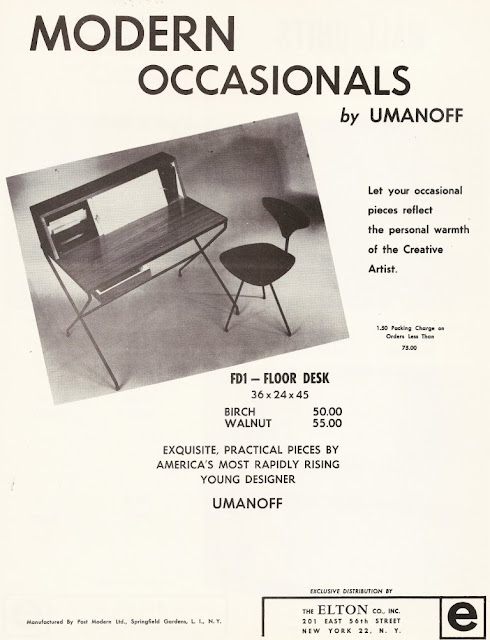Let's start at the beginning. For Arthur Umanoff the beginning is at the Elton Company where in 1952 his designs first began to be sold to the public. Little is known about this first collection as there seem to be no surviving photos from this time period and the only reference to it at all occurs as one line of text in a early Elton Co. advertisement in Interiors of June 1952.
 [1]
[1]
About the Elton Co itself we also know very little. According to
www.tonypauldesigns.com "
The Elton Company was a collaboration between Elliot and Tony" but when I contacted Lori the author of the site for clarification on this she was able to add very little. All we know is that Elliot was a ceramicist. Elliot is never mentioned again in any of the Elton advertising which I have come across.
By late 1952 Arthur Umanoff is seemingly no longer making "wonders in wood" and has taken to using a combination of materials in his designs.
"The Elton Company is proudly crowing about new furniture by a young Pratt and American School of Design graduate who chooses to be known by his last name only: Umanoff. He does dainty magazine and book racks and tables of wrought iron and either walnut or birch, tapered in slim delicate silhouettes. Desks come two ways: a wall hanging unit of birch or walnut is framed in black iron and has sliding doors of colorful masonite, while the standing version is mounted on tiptoed x's of the black metal. The hanging bar is on page 140 (seen below), complete to glass rack, handy pull-out work shelf, and towel bar.” [3]
 [2]
[2]
 [3]
[3]
Umanoff's work for Elton continues with the introduction of chairs,
 [4]
[4]
serving carts and a complete line of case pieces which get Elton and Umanoff chosen for the 1953 Good Design Exhibit at the Museum of Modern Art in New York City.
 [5]
[5]
The Umanoff designs for Elton were also featured in a two page pictorial in the October 1953 issue of Interiors magazine, images from this article are later re-used for the 1954 Storage: Volume 4 of the Interiors Library series edited by George Nelson.
 [6]
[6]
A few things we learn from this article are:
"Also illustrated is Umanoff's suspended-seat "swing" chair –– a rocker without rockers.” [6]
"Elton units depend for variation in use on varied arrangements of 8 basic fixed cases, which come in a choice of two depths, 16 and 10 inches (the latter unusually narrow width useful nowadays.)” [6]
"You can have only one "curtain" material –– lovely walnut veneer, but there is a choice of two metals for the frame –– shining brass or black wrought iron” [6]
It would seem that things were pretty good for the Elton Company but mysteriously there is no further mention of them after the October 1953 Interiors article, not a stitch. It's as if they have vanished from the face of the earth and this very well might be the case as the trail picks up in July of 1954 in a advertisement for Peter du Jardin's Tropic Shop in New York City.
"We have a "scoop" in this spectacular purchase of furniture. It's not just part of a line. . . but the entire manufacturer's inventory of 1036 pieces of beautifully designed, quality-crafted furniture. We bought it all at a gasping low price—and are offering everything at fantastic reductions!” [7]
 [7]
[7]
There's no mention of Umanoff or the Elton Company in the ad, none whatsoever, but there's no question that the chairs pictured are the Umanoff designed chairs for the Elton Company and if those are the Elton chairs then the cases must be from Elton too... and designed by Umanoff. The cases are properly credited to Umanoff in later advertisements.
 [8]
[8]
My best guess given the available information is that Elton went belly up sometime in 1953/1954 and that the Tropic Shop, with whom they were already doing business, picked up their remaining inventory.
Reference:
1: Interiors June 1952 page 191
2: Living for Young Homemakers April 1953 page 100
3: Interiors November 1952 page 140
4: Arts & Architecture March 1953 page 24
5: Interiors August 1953 page 149
6: Interiors October 1953 page 86
7: The New York Times July 1954 page 28
8: The New York Times April 1955 page 31









